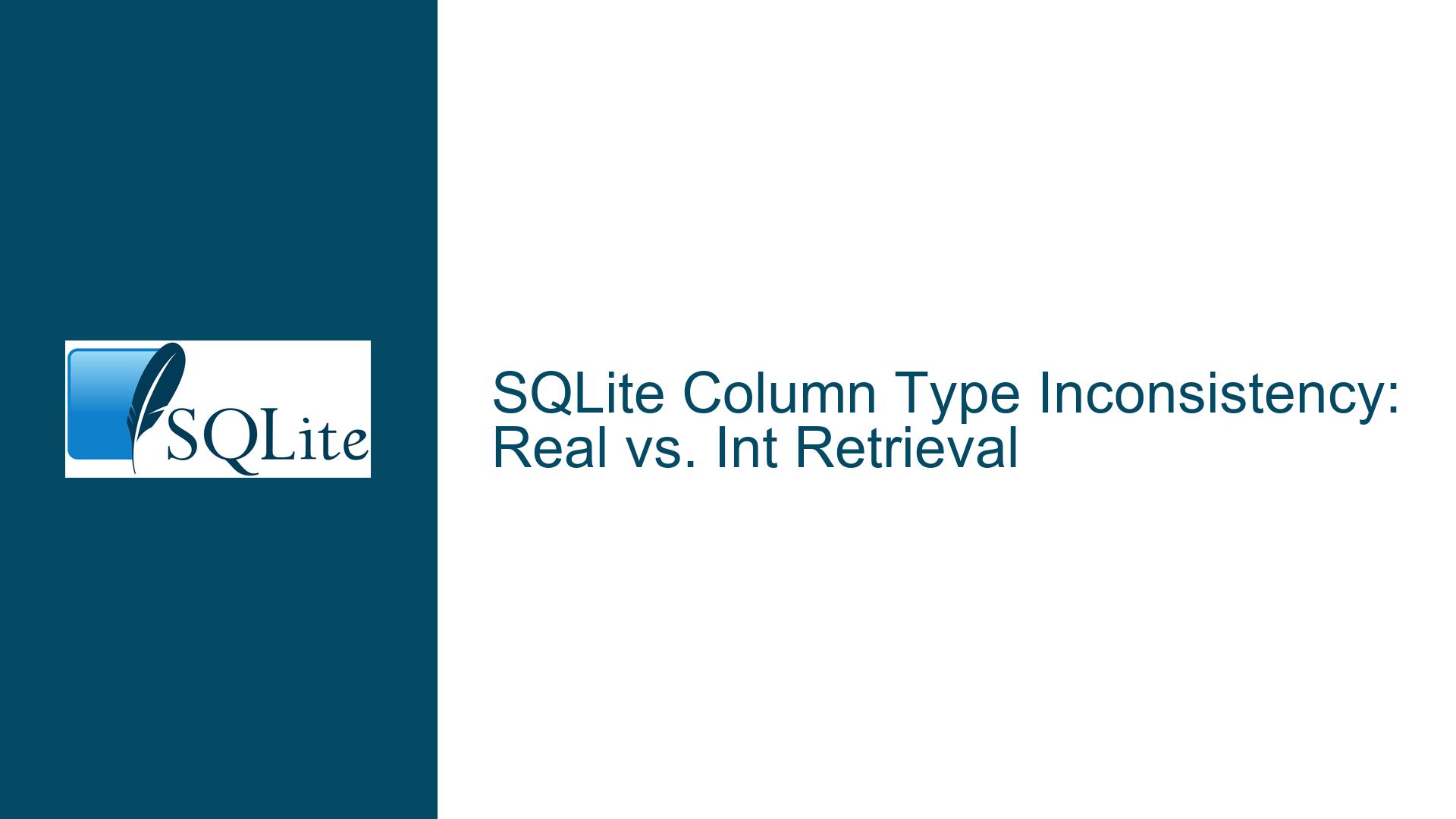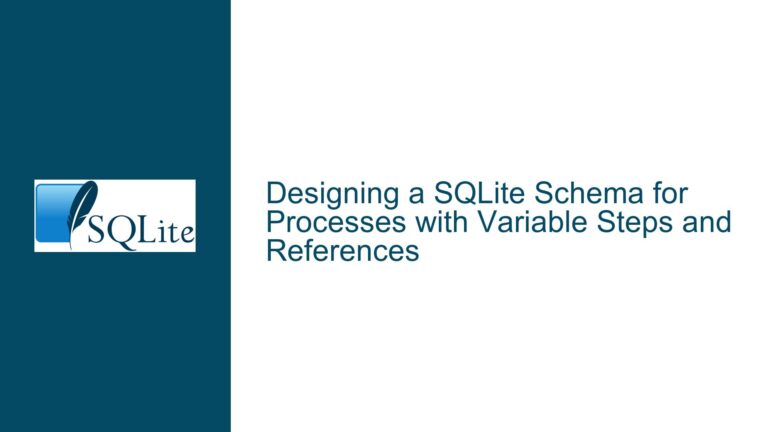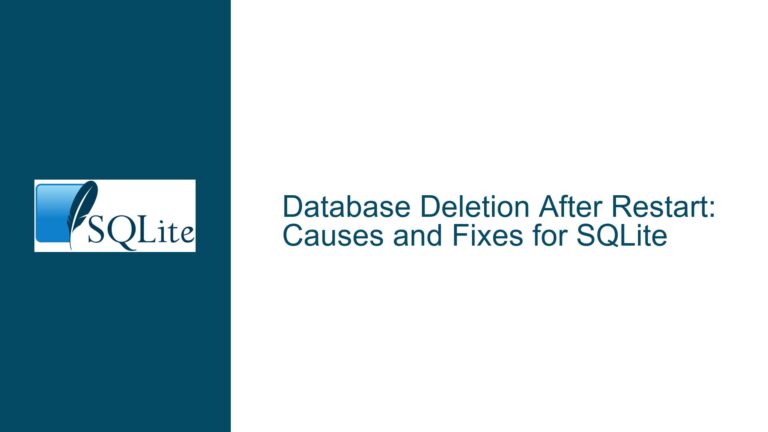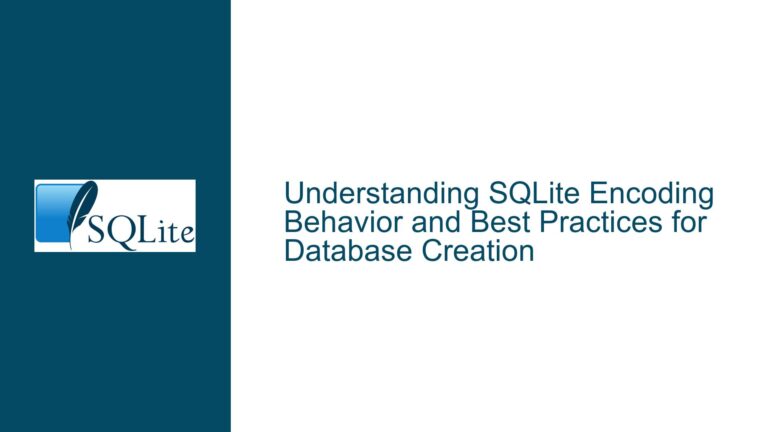SQLite Column Type Inconsistency: Real vs. Int Retrieval
Understanding SQLite’s Type Affinity and Storage Behavior
SQLite is a dynamically typed database system, which means that the type of a value is associated with the value itself, not with the column in which the value is stored. This behavior is governed by SQLite’s type affinity system, which determines how values are stored and retrieved based on the declared column type. When a column is defined with a type like REAL(4,2) or DECIMAL(4,2), SQLite ignores the precision and scale modifiers (e.g., (4,2)) and assigns a type affinity to the column. In this case, the affinity is NUMERIC.
The NUMERIC affinity in SQLite is designed to store values in the most efficient format possible. If a value can be represented as an integer, SQLite will store it as an integer. If the value has a fractional component, it will be stored as a REAL (floating-point number). This behavior is what leads to the observed inconsistency where a value like 3.0 is stored and retrieved as an integer, while 3.5 is stored and retrieved as a REAL.
The issue arises when applications expect a consistent data type for a column, particularly when the column is expected to always return a floating-point number. This expectation is not inherently met by SQLite’s type affinity system, leading to confusion and potential bugs in applications that rely on consistent data types.
The Role of Column Affinity and Data Storage in SQLite
To fully understand the issue, it is essential to delve into how SQLite handles column affinity and data storage. SQLite supports five storage classes: NULL, INTEGER, REAL, TEXT, and BLOB. The declared type of a column influences its affinity, which in turn affects how values are stored and retrieved.
When a column is defined with a type like REAL(4,2) or DECIMAL(4,2), SQLite assigns it a NUMERIC affinity. This means that the column will attempt to store values in the most appropriate storage class based on their content. For example:
- A value of
3.0is stored as anINTEGERbecause it has no fractional component. - A value of
3.5is stored as aREALbecause it has a fractional component. - A value of
'text'is stored asTEXTbecause it is a string. - A value of
NULLis stored asNULL. - A value of
x'31'(a BLOB) is stored as aBLOB.
This behavior is consistent with SQLite’s design philosophy of flexibility and efficiency. However, it can lead to unexpected results when applications assume that a column will always return values of a specific type, such as REAL.
The confusion is compounded by the fact that SQLite does not enforce strict typing. Even if a column is defined with a specific type, SQLite will still store values in the most appropriate storage class. This is why the original poster observed that values like 3.0 were being returned as integers, while values like 3.5 were being returned as floating-point numbers.
Solutions for Ensuring Consistent Floating-Point Retrieval
To address the issue of inconsistent data types when retrieving values from a NUMERIC affinity column, several approaches can be taken. Each approach has its own advantages and trade-offs, and the choice of solution will depend on the specific requirements of the application.
1. Using a View to Force Floating-Point Retrieval
One workaround is to create a view that explicitly casts the column to a REAL type. For example:
CREATE VIEW consistent_view AS
SELECT 1.0 * Column AS RColumn, OtherColumns
FROM original_table;
In this view, the expression 1.0 * Column ensures that the value is always treated as a floating-point number, even if the original value is an integer. This approach is simple and effective, but it requires modifying the application to use the view instead of the original table.
2. Using STRICT Tables for Type Enforcement
Another approach is to use SQLite’s STRICT tables feature, which enforces strict typing for columns. When a table is defined as STRICT, the declared type of each column is enforced, and values that do not match the declared type are rejected. For example:
CREATE TABLE strict_table (
Column REAL
) STRICT;
With this definition, any attempt to insert a non-REAL value into the Column will result in an error. This ensures that the column always contains REAL values, eliminating the inconsistency issue. However, this approach requires SQLite version 3.37.0 or later and may not be suitable for all applications.
3. Explicit Type Casting in Queries
A third approach is to explicitly cast the column to a REAL type in queries where consistent floating-point retrieval is required. For example:
SELECT CAST(Column AS REAL) AS RColumn, OtherColumns
FROM original_table;
This approach ensures that the column is always returned as a REAL value, regardless of how it is stored. However, it requires modifying all relevant queries, which may not be practical in large or complex applications.
4. Modifying the Column Affinity
If the application requires consistent floating-point retrieval and the column does not need to store integer values, the column can be redefined with a REAL affinity. For example:
ALTER TABLE original_table
MODIFY Column REAL;
This ensures that the column always has a REAL affinity, and values will be stored and retrieved as floating-point numbers. However, this approach may not be suitable if the column needs to store integer values.
5. Using Application-Level Logic
Finally, the application itself can handle the inconsistency by checking the type of the retrieved value and converting it to a floating-point number if necessary. This approach requires additional logic in the application code but does not require any changes to the database schema or queries.
Conclusion
The issue of inconsistent data types when retrieving values from a NUMERIC affinity column in SQLite stems from the database’s dynamic typing system and type affinity behavior. While this behavior is designed for flexibility and efficiency, it can lead to unexpected results in applications that expect consistent data types.
To address this issue, several solutions are available, including using views, STRICT tables, explicit type casting, modifying column affinity, and handling the inconsistency at the application level. Each solution has its own advantages and trade-offs, and the choice of approach will depend on the specific requirements of the application.
By understanding SQLite’s type affinity system and the available solutions, developers can ensure that their applications retrieve values in a consistent and predictable manner, avoiding potential bugs and confusion.






